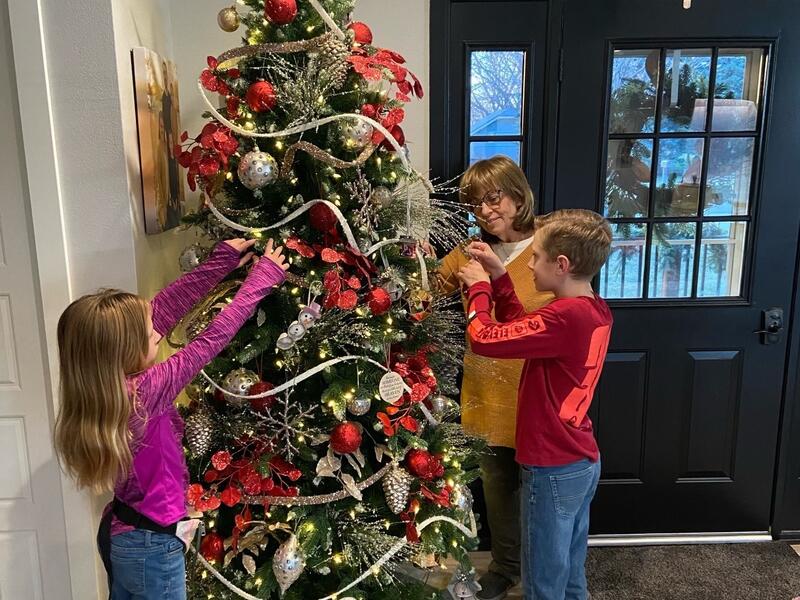Edie Kroon was born with Wolff-Parkinson-White syndrome, a rare condition that involves an extra electrical pathway in the heart. It has not stopped her from living a very active life, though it has sometimes provided her with new challenges.
Now in her 60s, she had her first open-heart surgery when she was 29. She has had two more since then with 21 surgeries overall.
“I’ve had a lot of things go wrong with me over the years,” she said, summarizing her medical history.
With help from the medical community – and her own personal resolve and energy – she has never slowed down. The occasional obstacle had never been enough to change that until she had a tricuspid valve replaced at a hospital outside the Sanford Health system.
In this case, unlike her other heart surgeries, she was slow to recover. She felt worse, in fact, with a full-time job and daily grandmother responsibilities becoming very difficult.
“I was absolutely exhausted by 5 o’clock,” she said. “I wouldn’t want to do anything. That was not the kind of life I was used to living.”
At the Sanford Cardiovascular Institute, she talked to her doctor about her fatigue, which should have been diminishing after the valve surgery. She took tests and then met with Sanford Health interventional cardiologist Tom Stys, M.D. Eventually they discovered the replacement valve was not working correctly. It was why she was so tired all the time.
The next step was finding a way to fix it.
Defining valve-in-valve
Following one open-heart surgery with another so soon was not what anyone wanted. Instead, Dr. Stys proposed a procedure that would not involve opening Kroon’s chest again. They would gain access to the affected valve through an artery in the groin area and put another valve inside the existing valve.
After Kroon discussed it with Dr. Stys, this approach seemed by far the best option. It would be the first time for such a procedure in the state of South Dakota.
Though new territory, the assembled team was well-prepared for expanding the scope of health care.
“We have an excellent group of interventional cardiologists, an excellent program and an excellent team,” Dr. Stys said. “That allows us to be innovative, progressive and practice cutting-edge technology that we can then bring to the community to help our patients.”
Kroon, who lives in Alton, Iowa, and works for Pella Corporation in Sioux Center, then went through a series of additional tests to make sure other vital organs were healthy enough to handle another heart procedure.
On Oct. 7, the Sanford surgical team performed the operation that would improve her life quickly and dramatically.
The next day Dr. Stys entered Kroon’s room smiling “ear-to-ear,” in Kroon’s words. He told her the team had inserted a new valve into the existing valve. She would start feeling better now, he said. The weeks and months that followed confirmed this promise.
Recently she and her husband Ken had another checkup with Dr. Stys. Again, the smiles were ear-to-ear.
“When this started, her shortness of breath was so limiting, she couldn’t do anything,” Dr. Stys said. “She was struggling psychologically because she needed so much help. But we were able to fix the valve problem. Her shortness of breath is gone now. She’s able to go out and live the way she wants to live.”
Alternative to open heart surgery
The procedure promises to improve lives of many patients in the future. By avoiding open-heart surgeries, recovery time is faster.
“It allows us to deliver care to patients who would otherwise be too high a risk for open-heart surgery,” Dr. Stys said. “We have patients who struggle walking because of chest pain and shortness of breath. You put a new heart valve in them with this procedure and they go home the next day and feel better right away. They’re able to function again. They’re able to go out with their friends.”
Kroon is back to being herself, you could say. She likes it that way and so do those close to her.
“It’s like a day-and-night difference for me,” she said. “I have two grandchildren who live half a block from me. I pick them up every day from school and bring them home. Sometimes I’ll have all the kids in the neighborhood over – they know how I am with cookies and candy. A year ago, I couldn’t live my life this way. Now I can.”
Over the years when Kroon would be visiting a doctor who she had not dealt with before, there would often be a moment where the doctor would glance at her chart, then look up and say, “Oh my, you’ve been through quite a bit, haven’t you?”
Yes she has. So when she talks about the quality of her care, she has plenty of personal experience to draw from.
“My Sanford doctors have saved me from a life of turmoil,” Kroon said. “They believed in me. They believed me when I said I wasn’t feeling well. I haven’t been treated so well in all my life. The nurses and doctors – it’s like they really care about you. I can’t say that enough.”
Often when a health system is able to expand its care, it is attributed a new machine or device. Of much more importance in most cases are the people behind the instruments.
“It’s not just new toys or gadgets,” Dr. Stys said. “Delivering this innovative technology – which is often very complex – demands physician expertise, knowledge and skill. And we need a facility and an administrative staff that can support it. All those pieces fall together very nicely for our program. It’s what makes us successful.”
Learn more
- Heart disease 101: Which symptoms matter most?
- Podcast: COVID and the important connection to heart health
- Open heart surgery patient continues rehab during pandemic
…
Posted In Heart, News, Sioux Falls
